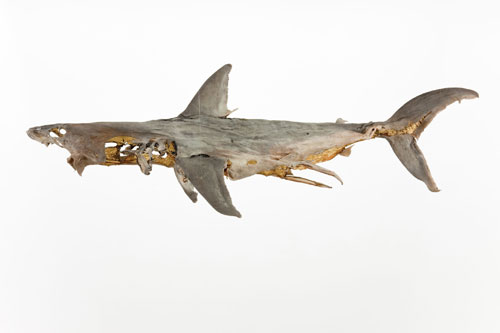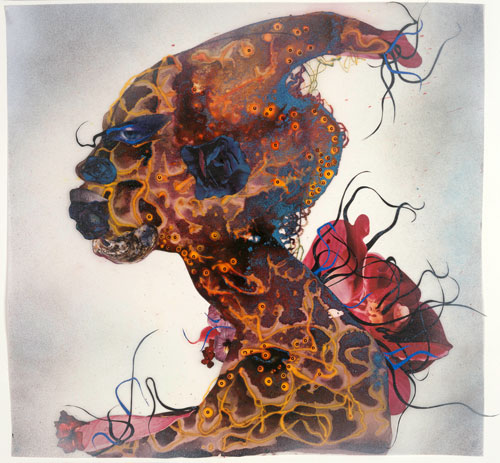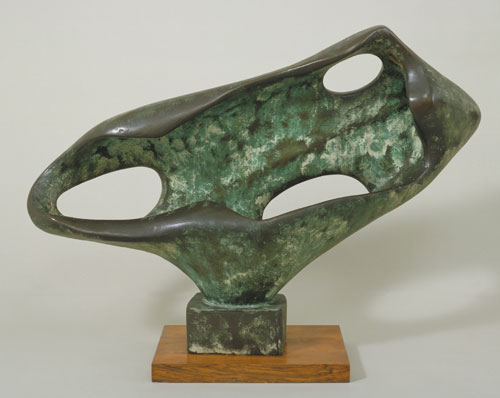

Tate St Ives, Cornwall
12 October 2013 – 26 January 2014
by JANET McKENZIE
A major and scholarly exhibition of contemporary and historic art, Aquatopia explores how the sea has fascinated humans for centuries: it presents more than 150 works drawn from public and private collections, including the Victoria and Albert Museum, the National Maritime Museum and the Tate’s own collections.
Important paintings, sculptures and drawings by JMW Turner, Marcel Broodthaers, Oskar Kokoschka, Barbara Hepworth, Odilon Redon, Lucian Freud, Hokusai and John Bellany, and more recent works by artists in video, performance, sculpture and painting such as Mark Dion, Marvin Gaye Chetwynd, and Wangechi Mutu establish a fascinating and broad spectrum of works that indicate the pivotal role the sea has played in many cultures. Science has not been able to dispel centuries of mythology and fictional accounts. Indeed, our actual knowledge of the oceans is significantly less than the plethora of fantasy and literary phenomena, some of which were created to frighten humans into a firm belief in God and a righteous path. A case in point is that of The Historie of Serpents (1608), a zoological inventory of God’s creations by the English cleric Edward Topsell, into which the author introduced a huge sea serpent. He recounted the story of a ship that was attacked by a monstrous beast 120ft long that allegedly ate a man in one mouthful as it lurched above the water. In his catalogue essay for Aquatopia, art historian Simon Grant points out that many of the eyewitness accounts of sea monsters were hearsay, made by religious figures: “Not only to remind neighbouring countries of [British] naval dominance, but also to capitalise on the potential of stories of hellish and fantastical creatures to induce faith into their communities.”
The ocean covers 70% of the Earth but more than 90% of its floor is still unexplored. More is known about outer space and the solar system than the depths of the seas, and each time maritime scientists mount an exploration of the deep sea trenches and underwater mountains, they return with images and evidence of the largest, weirdest “monsters” every bit as frightening as those of the imagination over the centuries. Dark and unfathomable, the ocean deep has always been used as a metaphor for depravity and moral depths. Alongside historic narratives and explorations, there have been countless terror-inducing myths and legends of sea spirits and menacing creatures. WH Auden described the sea as possessing that state of “barbaric vagueness and disorder out of which civilisation has emerged”.
Throughout history, and in all cultures, sea myths have existed, from the Greek goddess Ceto, who exemplified the dangers of the sea, to the Inuit’s Qalupalik, a monster that lives under the ice, and is used as an incentive to children to obey their parents. In Scottish folklore, selkies, specifically from the Orkney Isles (selkie is simply the Orcadian dialect word for “seal”), are seal-like creatures that shed their skin and take human form on dry land. The selkie-men were renowned for their many encounters with human females – married and unmarried. If a girl went missing on the coast, or at sea, it was inevitably said that her selkie lover had taken her.
The sea is a captivating subject where stories of metamorphosis, spiritual journeys and narratives of fantasy and fear are inherently surrealist in nature: Willem Ormea’s Fish Still Life with Seascape (1649) and Redon’s The Beasts of the Sea, Round Like Leather Bottles (1896) fit in seamlessly with Turner’s Sunrise with Sea Monsters (c1845) and the dramatic images of fisher people by Bellany, whose early work is the product of a maritime upbringing in the fishing villages of Port Seton and Eyemouth near Edinburgh, on Scotland’s east coast. The close fisher community imbued Bellany with a love and respect both for family and community, and for the strict Christian values that dominated daily life in a fishing community.
Numerous artists in this exhibition have been inspired by literary masterpieces that evoke mysterious images of the sea: The Odyssey, The Tempest, The Ancient Mariner, Moby Dick and Twenty Thousand Leagues Under the Sea. In their foreword to the exhibition catalogue, Alex Farquharson and Martin Clark observe: “Unsurprisingly, the deep was a favourite motif for the surrealists. Salvador Dalí delivered a lecture in a deep-sea diving suit at the opening of the International Surrealist Exhibitionin London in 1936, and, like a fish out of surrealist waters, nearly suffocated in the process. For Sigmund Freud and his followers, the unconscious accounts for nine-tenths of the psyche, which equates to the proportion of the deep that remains unknown. We conjoin the concepts when we speak of being in deep sleep.”
In Greek mythology, the Sirens were dangerous and beautiful sea nymphs portrayed as femmes fatales who, with their enchanting music and voices, lured sailors to shipwreck on the rocky coast of their island. Sirens have been referred to as the muses of the lower world: their irresistible song would lull the male body and soul into a fatal lethargy and lead them relentlessly towards a sticky end. Sirens combine women and birds in various ways. In early Greek art, Sirens were represented as birds with large women’s heads, bird feathers and scaly feet. Later, they were represented as female figures with the legs of birds, with or without wings, playing a variety of musical instruments, particularly the harp.
The myth of the Greek god Odysseus (known as Ulysses by the romans) and the Sirens is an abiding narrative conjured by the imagination of the 19th-century painter John William Waterhouse, Ulysses and the Sirens (1891). In the exhibition catalogue,a scholarly interpretation of mermaids and sea witches by Marina Warner includes The Little Mermaid (1837) by Hans Christian Andersen, the story of a young mermaid willing to give up her life in the sea and her identity as a mermaid to acquire a human soul and the love of a human prince. A story with an inevitably grim end: the sea witch advises that to become human she must have her tongue cut out, but that is not sufficient and she loses all innocence and still dissolves into sea foam. The Little Mermaid in the Disney film, however, is a fairytale heroine of romantic love with long red hair, a doll version of which is also available complete with hair comb and mirror and a happy end.
Jean-Baptiste Siméon Chardin’s famous Lenten Still Life (1728) was described by Marcel Proust as the depiction of a “strange monster”. The monster was, in fact, a naturalistically rendered skate. It inspired Australian artist Arthur Boyd’s portrayal in Australian Scapegoat (1987), and Bellany, who used it to display a form of vulnerability. Boyd used the skate to express his opposition to the cruelty of war and to violence. In the fishing villages of Scotland, the skate had other associations: it was thought to enhance libido, so girls were allowed to eat it but boys were not. The fish was considered by fishermen to be vicious and thorny, capable of inflicting injury. It was known as a weird demon of the deep and was associated with the primitive force of the sea. The squid in Freud’s Still Life with Squid and Sea Urchin (1949) is slumped where one would normally expect a nude in his work. A human-like thing with uncannily realistic skin and a monstrous physiognomy, it returns one’s gaze with a single large dead eye.
The white whale in Melville’s Moby Dick (1851) symbolises here man’s quest for truth and satisfaction. The whale is also presented as a sea-faring monster; it alludes to the capacity for the sea to give (a livelihood) and also to destroy. The white whale has also been seen as a symbol for many things, including nature and those elements of life that are beyond human control. A number of biblical themes can also be found in Moby Dick, including multiple implicit and explicit allusions to the story of Jonah; the Old Testament story chosen by Boyd to illustrate the poetry of Peter Porter . Bellany identified with the central character, Ishmael who has come to symbolise exiles, and social outcasts – in the opening paragraph of Moby Dick, Ishmael tells the reader that he has turned to the sea out of a feeling of alienation from human society.
Samuel Taylor Coleridge’s The Rime of the Ancient Mariner is the narrative of a long sea journey in which a ship is blown off course by a storm and ends up in Antarctica. An albatross (symbolising the Christian soul) appears and leads it out of the Antarctic. The mariner shoots the albatross and thus begins his punishment by the spiritual world via nature. Retribution in verse takes the form of natural phenomena: the wind drops, the sun intensifies, and the ocean becomes revolting, “rotting” and thrashing with “slimy” creatures and sizzling with strange fires. Only when the mariner expresses love for the natural world – in the form of the water snakes – does his punishment begin to abate. The Ancient Mariner preaches respect for the natural world as a way to remain in good standing with the spiritual world, for in order to respect God, one must respect all living creatures.
Aquatopia is a large, widely sourced exhibition with diverse examples of the role of the sea in the imagination of artists over the centuries; it provides endless opportunities to muse on the power of the unknowable and mysterious in all human cultures. The abiding power of the sea to mystify sailors and interested parties alike is evident in the story of the Mary Celeste, found on the 4 December 1872 drifting in the Atlantic, seemingly abandoned in haste. For mariners, this has become a contemporary fable still unsolved. There is not more fitting venue for this exhibition than at Tate St Ives, a maritime community if ever there was one.
Aquatopia: The Imaginary of the Ocean Deep is a collaboration between Nottingham Contemporary (20 July - 22 September 2013) and Tate St Ives.


